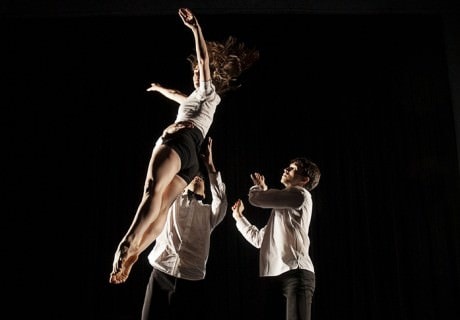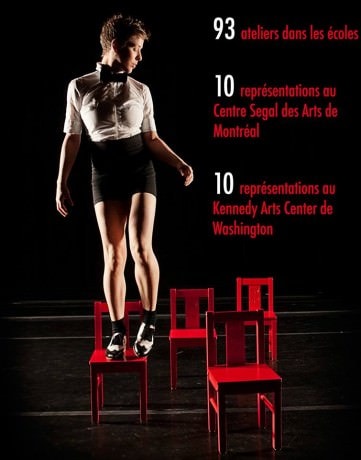I knew this was going to be a good performance when I saw the on the Web that it was choreographed by Hélène Blackburn and Pierre Lecours, “with the invaluable collaboration of dancers.”

Blackburn and Lecours have captured in movement what it means to be young. Dancers Merryn Kritzinger, Alexandre Carlos, Roxanne Duchesne-Roy, Daphnée Laurendeau and Jean-Philippe Giraud are so infectiously talented that Kendall, a seven-year-old hip-hop student from Columbia, MD., left the theater with plans to incorporate a red rubber handball into her routine.
Cas Public is a dance company from Montreal, Canada, that incorporates everyday items and sounds in its performances. GOLD is performed to Johann Sebastian Bach’s Goldberg Variations. Originally written for harpsichord, they were recorded on piano by Glenn Gould for the performance.
Here’s what I like about the Family Theater at the Kennedy Center: They give you a performance guide called the “Cuesheet” that explains things about the show. For example, “When writing Goldberg Variations, Bach composed no less than 30 variations to his original theme. They are sandwiched between an expressive melody called an aria (pronounced AH-ree-yah) played at the beginning and again at the end. In GOLD, the aria is heard at the very beginning of the work.”
The beginning of the show is totally entrancing. The dancers walk back and forth across the stage in front of, behind, and between panels by Martin Bryson and Samuel Thériault that are also sliding across, creating a hide-and-seek effect with stop-action poses.
Blackburn and Daniel Fortin created costumes that resemble street clothes, with black pants and white shirts with black bow ties and suit jackets for the males, and and overcoats with red flower shapes for the females. All the dancers wore saddle shoes.
It is immediately obvious that light by Andréanne Deschênes is the sixth dancer in this show, and in the opening number, it is rectangles of white light that are interacting with the dancers. Watching the spaces created by it–and how the dancers used them–is spellbinding.
The “Cuesheet” gives us a hint on this as well.
“In order to play Bach’s music on the piano, Gould needed to cross one hand over the other, sometimes very quickly, in order to reach the right notes. Other times, the themes played by the right hand “passess” to the left. This also happens in the movement, specifically when the dancers bounce the balls. Watch how they cross their hands, pass the ball from one hand to the other, and pass the ball to each other.”
. . . or put the balls in front of their eyes so they look like a bug, which got a big laugh. Another thing that got a big laugh from the youngsters in the audience was a number in which two dancers took turns singing the notes and using each other as percussive instruments until it became clear that they were calling each other names (dumb dumb dumb) and hitting each other. The adults in the audience were obliged to disapprove, and the kids loved it.
A recurring sound motif was that of a ringing telephone, which was not one of Bach’s original variations, Kendall’s adult noted wryly. The bell rang, the harmonics lingered, the dancers’ bodies formed tremolos. Was it a commentary on the cacaphony of modern existence? Perhaps. Were the adults in the audience rattled by it? Completely. Did it bother the kids? Nope.
When the ringing faded, it was a special treat to hear the tinny strands of harpsichord, once almost threatened to be a lost art, on some of the numbers, and the choreographers made good use of its syncopation with robot and moon-walk maneuvers like Michael Jackson, along with some moves that would give Marquese Scott a run for his money. Also featured were a dancing chair and scuttling beetles (robots by Martin Bryson, Svodimir Segaric and Thériault), video (by Thériault and Josué Bertolino) of the pianist, as well as some animated projections.
My favrorite dance involved red miniature chairs that were placed in front of a dancer like a moving walkway. Every time he stepped off of a chair, it was whisked in front of him so he could take the next step.
Each dancer has his own style–ballet, tap, jazz, hip-hop, gymnastics–and each one is a gift to the ensemble, which is far greater than the sum of its parts. In a group dance toward the end of the performance they were all moving in their own ways, together, but differently. Like that line of chairs, it was like they momentarily nailed down a small part of what it means to be human. Call it joy.
Running time: 45 minutes.
GOLD plays today – January 26, 2014 at 1:30 pm and 4 pm at The Kennedy Center Family Theater – 2700 F Street, NW, in Washington, DC. For tickets, call the box office at (202) 467-4600, or purchase them online.
https://youtu.be/PAJdizQdKrA
https://youtu.be/n5cTJnTVi5A
https://youtu.be/fBdI9cD069M
https://youtu.be/PvGjfsW8vtk
https://youtu.be/tf6ZtzqEATQ
https://youtu.be/y4G86E5da3Q





